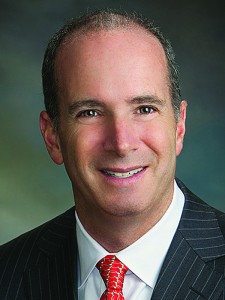
Wells Fargo Capital Finance
The year is off to a good start, perhaps having summoned its energy from an accelerated fourth quarter or because the beginning of 2016 provided an easy record to beat. We asked our panel of seasoned ABL executives to put the current marketplace into perspective for us.
“A year ago the capital markets were suffering,” says Barry Bobrow, managing director and head of Loan Sales and Syndication at Wells Fargo Capital Finance. “M&A volume was way off, and the high yield market was pretty much shut down. While we haven’t seen a big uptick in M&A, markets overall are in much better shape, leading to a wave of refinancing activity. While we could yet see some more acquisition activity, I think we are in a refinancing-driven market for the rest of the year.”
“While the level of new deals remains fairly low, our activity level versus the same period last year has modestly improved,” says Sam Philbrick, president of U.S. Bank Asset Based Finance. “The large ABL market is relatively quiet with most of our new activity occurring in the middle market space.”
“From a new business standpoint, 2017 looks a lot like 2016,” says Michael W. Scolaro, managing director and group head of Asset Based Lending at BMO Harris Bank. “We are seeing solid but not huge demand from our borrowers. Business is steady; we no longer see the peaks and valleys of the past.”
“We are having an excellent year,” says Ira Kreft, senior vice president and central region marketing manager at Bank of America Business Capital. “We’ve had some good opportunities to refinance cash flow deals, and the private equity sponsors that we work with have been the winning bidder in more cases.”
Michael Sharkey, president of MB Business Capital, is having his best start to the year since 2009. “Our new business volume is up significantly, largely related to refinancing and recap. It seems that business owners feel the market has been stable for some time and perhaps now it is OK to seek a new lender and establish a relationship with a new source.”
“In the last few years, many middle market private equity sponsors have been sellers because of the attractive valuations,” Kreft says. “Heavy competition and lofty purchase price multiples have kept buyers on the sidelines, especially for new platform companies. Sponsors are finding more attractive valuations in certain industries — such as automotive suppliers and building products — and ABL financing has been the structure of choice. The ability to pair ABL with different forms of capital — such as direct term lenders, mezzanine, high yield and convertible bonds — has increased the array of situations where ABL financing can be competitive.”
“From a syndicated market standpoint, the first quarter of 2017 was up sharply from the first quarter of 2016,” Bobrow says. “There were six deals in the first quarter that were $1 billion-plus versus 11 for all of last year. That drove a much better first quarter. Based on the jumbo trend, we expect this year to track ahead of last year, which was down 15% from the year before.”

Both Philbrick and Sharkey have noticed utilization increases within their customer base. “Several of our existing clients utilized their existing ABL facilities to fund certain activities in addition to their normal working capital financing,” Philbrick says. “These one-time events include funding a dividend, making an acquisition and prepaying relatively expensive term debt. This type of activity generally indicates our borrower’s confidence in the economic picture, which is a positive.”
State of the Economy
“I think the economy is pretty good, but the impact of the growth is somewhat uneven,” Bobrow says. “Interest rates are normalizing because the economy is stronger, but it’s not dramatically better. Lenders are eager to lend, but I don’t foresee a flood of new M&A transactions. The fact that the equity markets have backed off from the peak is indicative of a rethink on whether acquisitions are the right strategy at this point.”
“In 2016, new money deals represented about one-third of all ABL financings in the marketplace,” Kreft says. “That showed a rise over the prior five years, but, in the first quarter of 2017, the deals reverted to about one quarter of ABL financings. There isn’t a large maturity wall that will boost refinancings. However, rising interest rates and weaker operating performance in various sectors could drive companies to refinance cash-flow credit facilities with ABL.”
The balance of supply and demand follows the same tedious path with little change. “The refinancings are bid aggressively, and the banks step up to bigger and bigger numbers,” Bobrow says. “Last year we saw the closing of the largest asset-based deal ever, when Southern Wine & Spirits merged with Glazer’s, resulting in a $4.7 billion asset-based deal. That is a sign that there is very healthy demand for those kinds of assets. The challenge comes when you have a loan that is not in conformity with the regulatory guidance on leveraged lending; then it’s a very difficult deal to do.”
“The banking sector is still ready to lend,” Philbrick says. “To me, it is a question of whether this slow growth economy will shift into higher gear at some point and improve the demand side of the equation. Toward the end of 2016, we saw solid improvement in our customer base in the metals sector, where there has been a rebound in commodity prices. The increase in inventory values and business activity has led to some improvement there, and those companies are performing better.”
“The most recent Federal Reserve survey of bank credit standards noted that lending standards for C&I loans are back in neutral after four consecutive quarters of tightening,” Kreft says. “As a result, we expect continued strong demand for loans from commercial banks through 2017. The non-bank lenders have strong demand for loans as well.”
“As an originator and as a participant, we continue to see over-subscription of loans where the syndication of a transaction has become relatively easy for performing credits,” Scolaro says. “There is an upsurge in hold levels in every segment of our asset-based business, and they keep getting larger. A new phenomenon is the willingness of people to do a sole bank transaction where previously those deals had involved two or three banks. They are all driven by the imbalance in supply and demand.”
“It’s definitely getting more competitive all the time,” Sharkey says, whose company is in the midst of a strategic planning process. “We identified 51 bank-owned ABL competitors across our national footprint, and that does not count the independent finance companies and other alternative lenders. Four years ago, we counted less than half of that. Our response, thanks to strong support from our parent, MB Financial, has been to open more offices. The theory is: If we are going to win on half as many proposals as we did a few years ago, we had better be proposing on twice as many deals.”
Weakening ABL Marketplace?
A recent assessment of the ABL space from Thompson Reuters LPC noted a drop-off in deals. “While we would like to see more ABL volume and deals financed with ABL structures, the noted decline was due more to the increase in cash-flow leveraged lending than to a pure decline in ABL volume,” Kreft says. “The leveraged loan market has been strong in 2017 with year-to-date volume more than doubling from the same period in 2016. In addition, syndicated ABL volume is offset by strong activity in small to mid-cap sole-lender deals.”
“I haven’t seen a drop-off in the number of deals we are reviewing,” Sharkey says. “In fact, due to our ‘go big’ strategy, we are seeing more. Because of the multiples, strategic buyers end up with most of the deals, and they usually don’t require financing.”
Scolaro has not witnessed a drop-off either. “We are up year over year and have noticed significant activity from our existing ABL portfolio. Companies are tinkering with their capital structures and using ABL debt to make a large number of strategic acquisitions. We have talked within the industry about whether the league tables should include club transactions. Many issuers have shown reluctance to have a bank underwrite and arrange the syndicate for them when they can pull together a club transaction on their own. We are not seeing nearly the underwriting demand we once did.”
Bobrow points out that the Thompson Reuters league tables address only the syndicated market. “Because more and more market participants are holding larger amounts, you get a growing number of unreported transactions. If you hold the whole thing, maybe with another bank, it doesn’t count and goes unreported. If the market was off 15% last year, it doesn’t mean the market was off 15% — it just means that the syndications statistics were off 15%.”
When a company raises senior debt financing, it chooses the financing alternative that will provide the greater debt capacity while also considering financial flexibility. “Typically ABL is the preferred structure for companies with relatively low operating margins and high investment in assets,” Philbrick says. “We are not generally the choice for high margin businesses with low investment in working capital. In a market where the operating performance of companies has improved, financing options shift. As cash flows grow, the ability to borrow against that cash flow increases, and that makes the cash-flow credit product more attractive.”
New deal supply is muted, and the large syndicated ABL market continues to be flat, but club deal activity has increased. “While many lenders have ample hold levels, borrowers balance their bank group size between having sufficient financing partners and the ability to satisfy those partners with cross-sell opportunities,” says Kreft. “In exchange for better quality credits in club and sole-lender situations, lenders are willing to increase their hold levels, and that reduces participation opportunities. In some club ABL executions, the size of the bank group has been halved compared to the existing cash-flow bank group.”
Sharkey sees no shortage of prospects, and MB Business Capital’s backlog is at record levels. Scolaro also reports more new deal activity in the backlog than ever before: “We have made an effort to call on clients in industry verticals over a long term, and we also added experienced marketing people across the country. This is starting to pay off, and our backlog right now is twice the size it was at this time last year.”
“In 2017 there have been two new jumbo deals so far, but the new money activity is a relatively small portion of the overall market,” Bobrow says. “That hasn’t changed much from last year. The cash flow market is strong. If you look at the institutional market, it is on fire this year, but refinancing is driving it all. People are just bidding down the pricing on existing deals. The only thing that would lead to an increase in new money is M&A activity or a decline in credit quality that brings ‘fallen angels’ from cash flow to ABL. With the economy growing at 2%, ABL growth will be more sector-specific.”

“The new deal activity for the balance of 2017 will depend largely on the strength of the economy and business’ confidence in the strength of the economy into the future,” Philbrick says. “While the economic expansion looks to continue, there remains a high level of uncertainty that makes it hard to predict the economy’s longer term direction.”
Game Changers
“We have noticed the M&A activity smooth out over the calendar year, and there is no longer an August or December lull for the holidays,” Scolaro says. “However, the number of books we have seen from a buyout standpoint is down 8% to 10% across the board, regardless of industry.” Sharkey agrees: “The buy-out market has moved away from traditional ABL. I don’t expect that to change any time soon.”
“Strategic buyers with ample liquidity are active in the middle market where they can often pay a premium above the private equity sponsors,” Kreft says. “The $1 billion-plus funds came down to the middle market in pursuit of acquisitions, pushing out the smaller competition. For private equity sponsors, transactions under $100 million in value represented 70% of all deals completed in 2016; nearly half were $25 million. Moreover, add-on acquisitions represented nearly two-thirds of all buyout activity in 2016.”
“Healthcare and other sectors are the most active, but that is not where the ABL product brings value,” Philbrick says. “Retail is the largest industry sector financed by ABL, and clearly there is contraction rather than expansion in that marketplace. For the first quarter of 2017, total M&A-related asset-based lending represented only 3% of total ABL syndicated volume. That’s very low.”
“It would probably help M&A activity if we could get some clarity around tax policy changes and specifically the deductibility of interest,” Bobrow says. “People who use debt for acquisition activity will hold back if they don’t know whether interest will be deductible as a corporate expense. If a company buys another company with stock, they aren’t putting on any debt and the tax changes are not an issue. But if a sponsor using debt finds out it can’t deduct the interest, the cost of the debt just went up a lot!”
While interest rates are on the rise, they are still at attractive rates for borrowers. “In the cash-flow market, the financial covenants typically have some cushion that could tolerate a rate increase,” Kreft says. “However, companies with floating rate debt that operate in a more challenging industry or experience company-specific issues may have less tolerance for a rise in rates. If credits move from cash flow to ABL, that could be positive for our industry; but for existing clients, there could be some mild degradation of credit quality.”
“Because we fund virtually our entire loan book with low cost deposits, rising interest rates will help our margin,” Sharkey says. “Our deals are fully secured and not overly leveraged, so our borrowers should be able to handle the increases. Multiples on buy-outs may trend down and make those deals easier to finance on a conventional ABL basis. Highly leveraged cash-flow deals may start to bust out, and that will create a robust restructuring market for us, similar to what we saw in 2009 and 2010.”
In anticipation of higher rates, Scolaro finds that more customers and prospects want to discuss hedging options at the outset. “In the past, it was the bank that brought up the notion of a swap in order to complete a cross-sell and to further monetize the relationship. Now, even during the first meeting, our clients want to talk about swaps, hedges, caps, collars and forward-starting swaps. They want to prequalify BMO Harris as an issuer based not only on the terms of the asset-based product but also on our capabilities for doing swaps and derivatives.”
“Generally banks benefit from rising rates, because there is a lag between the immediate upward impact on assets while deposit costs don’t move up at the same rate,” Bobrow says. “Rising rates for any bank ABL would be a positive thing. It would widen our net interest margin which has been getting tighter and tighter over the last few years.”
“I believe potential changes in corporate tax law could be a more significant issue,” says Philbrick. “If a company can more tax-effectively repatriate cash from overseas, a significant amount of liquidity could flow into the U.S. and spur M&A activity. Taxes on imports would have a huge effect on some sectors, especially retailers that rely significantly on imported goods.”

According to our panel, the fintechs don’t pose much of a threat, though Sharkey warns, “Technology moves fast, and it is conceivable that at some point the fintechs could enter the world of highly monitored lending.”
Conversely, alternative lenders play an increasing role. “While alternative lenders don’t provide what we do, they are frequently involved in financings,” Philbrick says. “At times they will provide another part of the capital structure that, from a risk standpoint, we would shy away from.”
“Non-traditional alternative lenders are able to underwrite and hold large positions in companies that are experiencing some level of financial distress, so working with them becomes a mutually beneficial relationship,” Scolaro says. Bobrow agrees. “The ability to work together with alternative lenders in a combination capital structure or unitranche is good for us, since it allows us to address more of a company’s needs.”
“The alternative lenders focused on the tougher turnaround and hard collateral deals — these are the deals that tend to be criticized or classified in a bank environment — will continue to squeeze the bank lenders on the lower quality deals,” Sharkey says. “While we may offer those companies an alternative based upon a conservative structure at a good price, the alternative lenders can fully margin all of the collateral at a higher price. These borrowers tend to seek maximum liquidity and are not as concerned about price. This makes the alternative lender’s offering very attractive.”
Looking ahead, Kreft says, “We are actively considering how to leverage technology and data analytics and are conscious that the pace of technological innovation is happening quickly. We are always evaluating ways to improve our processes to better serve our clients while being more effective and efficient.”
Expectations for 2017
“We expect the rest of 2017 to provide a challenging environment with deal flow that is mostly refinancing,” Bobrow says. “Banks must be mindful of their costs while looking to broaden their business. The existence of jumbo deals early this year leads me to believe 2017 will be better than 2016.”
“An increase in large cap M&A activity would further bolster the increased activity in small-to-mid cap M&A that we’ve seen,” Kreft says. “This combined with a migration from cash flow to ABL structures for companies undergoing industry or company-specific challenges would be positive for our market.”
“This year we have already closed as many deals through March as we did last year through June,” Sharkey says. “Our backlog is also much stronger than it was last year at this time.” Scolaro says his company made great inroads into industry verticals such as metals and transportation. “We also took advantage of our internal partnership with other areas of BMO Harris — these are the geographic and industry specialty areas that have allowed us to marry local coverage and industry knowledge with our asset-based product.”
Bobrow has noticed an increasing market focus on return and risk-adjusted return. “That leads to more competition for loans that make sense from a regulatory standpoint in addition to competition for the ancillary income that companies will spend. Many banks are showing good discipline: If they don’t think they can get their fair share of the non-credit income, they won’t play. That, in itself, could hold pricing steady.”

“Business owners seem more open to changing lenders, and that helps offset the lack of buy-out activity,” Sharkey says. “We will continue to see our customers sell at high multiples that normally attract strategic buyers who don’t need our financing. That makes growth challenging, but overall I am expecting our business to grow more this year than it has for the last two years combined, though I don’t expect that growth to be dramatic.”
“I don’t foresee the market going up like a rocket at the end of the year, but I think it will be a good steady market with some increases,” Kreft says. “Two more interest rate hikes this year could cause problems for some stressed companies. For example, the automotive sector has softened a bit, and a cutback in production could negatively affect their suppliers. There are also the company-specific issues of failed strategies and execution. As long as there is no regulatory deterrent to lending to those companies, a little stress is good for the ABL market. It creates lending opportunities for us.”
Bobrow recognizes that other ABL-related business options might be worth exploring. “We see more appetite for lender finance and more demand for healthcare ABL. There is also more interest in supply-chain financing, which is ABL with different structures. We have been active in all three, and I think the market is looking at these options to learn if there are other ways to grow business.”
All in all, the success of asset-based lenders always comes down to what the economy will bear. “There is a level of uncertainty, whether it be the length of the current economic expansion or potential geo-political events,” Philbrick says. “It seems that the economy will chug along as it has for the past couple of years. If the new administration takes action to stimulate the economy, that would change my outlook. In the meantime, I am expecting slow and steady for the balance of the year.”
